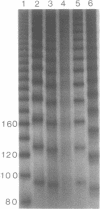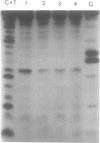Abstract
Modification of DNA and double-stranded deoxyoligonucleotides with antitumour 1,2-diamino-cyclohexanedinitroplatinum(II) (Pt-dach) complexes was investigated with the aid of physico-chemical methods and chemical probes of nucleic acid conformation. The three Pt-dach complexes were used which differed in isomeric forms of the dach nonleaving ligand-Pt(1R,2R-dach), Pt(1S,2S-dach) and Pt(1R,2S-dach) complexes. The latter complex has lower antitumour activity than the other two Pt-dach complexes. Pt(1R,2S-dach) complex exhibits the slowest kinetics of its binding to DNA and of the conversion of monofunctional binding to bifunctional lesions. The anomalously slow electrophoretic mobility of multimers of the platinated and ligated oligomers suggests that bifunctional binding of Pt-dach complexes to a d(GG) site within double-stranded oligonucleotides induces bending of the oligomer. In addition, chemical probing of double-helical deoxyoligonucleotides modified by the Pt-dach complexes at the d(GG) sites reveals that Pt(1R,2S-dach) complex induces more extensive conformational changes in the oligomer than Pt(1R,2R-dach) and Pt(1S,2S-dach) complexes. It is proposed that different effects of the Pt-dach complexes on DNA observed in this work arise mainly from a steric crowding of the axially oriented cyclohexane ring in the DNA adduct of Pt(1R,2S-dach) complex.
Full text
PDF
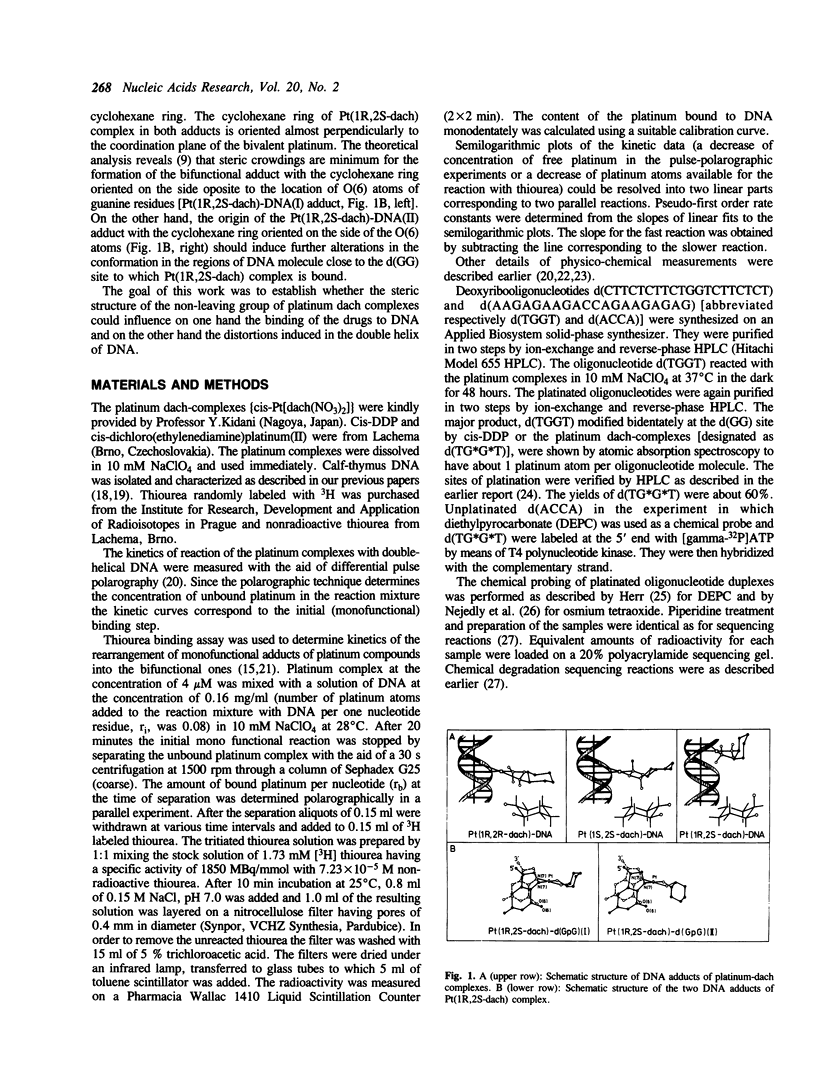
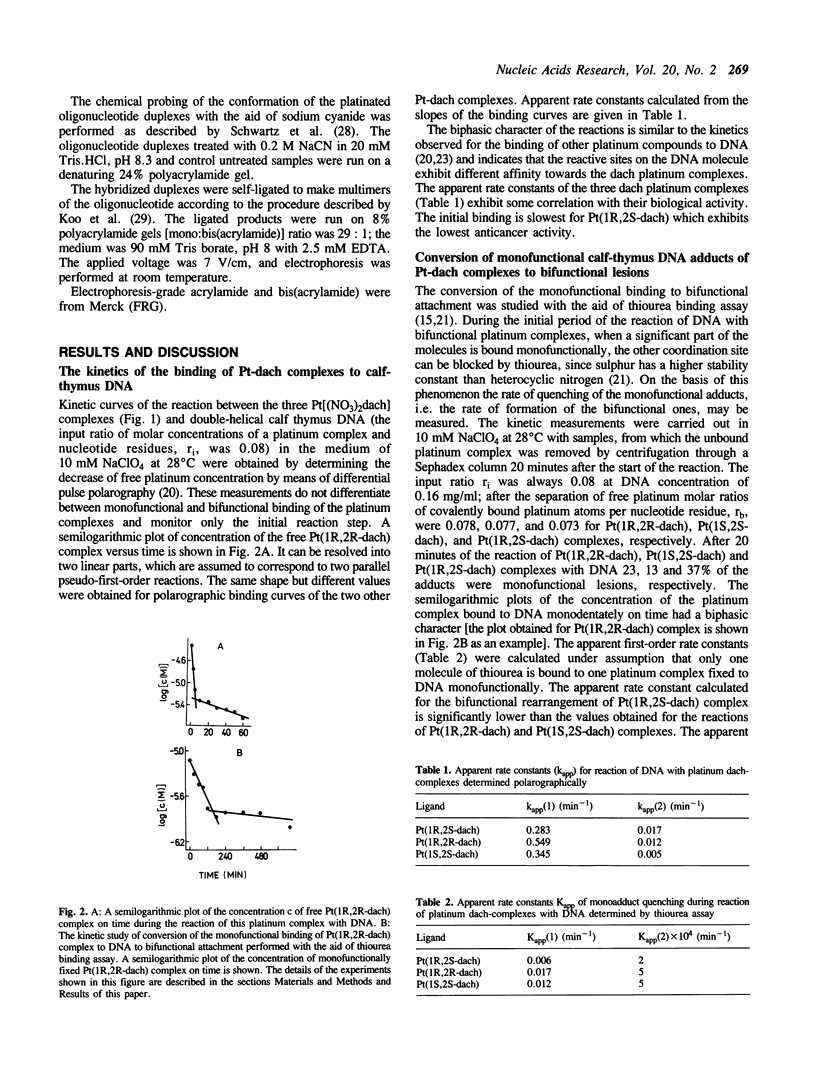
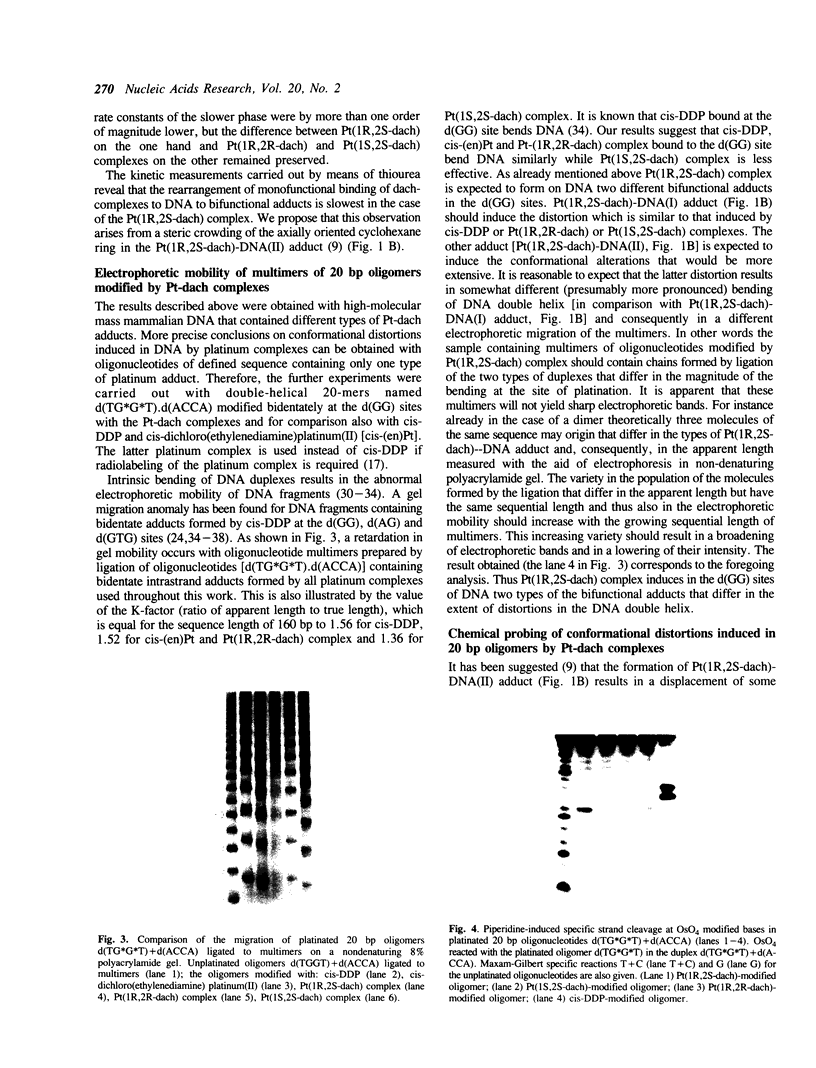
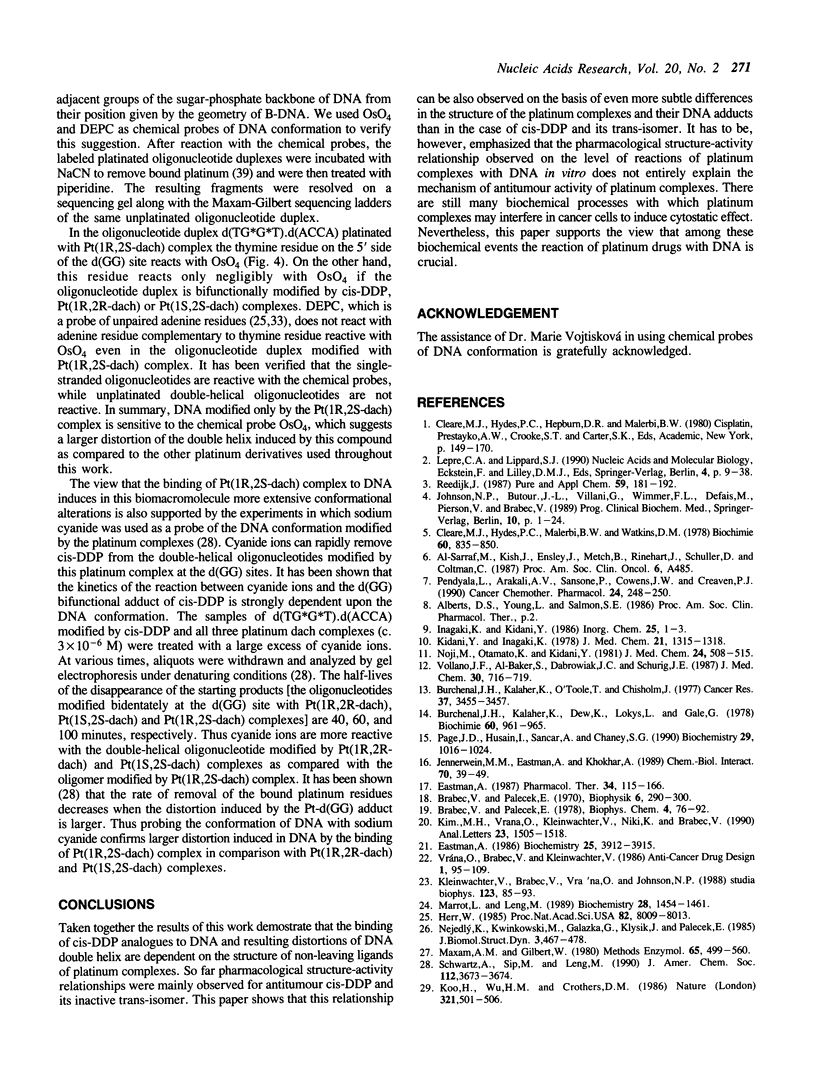
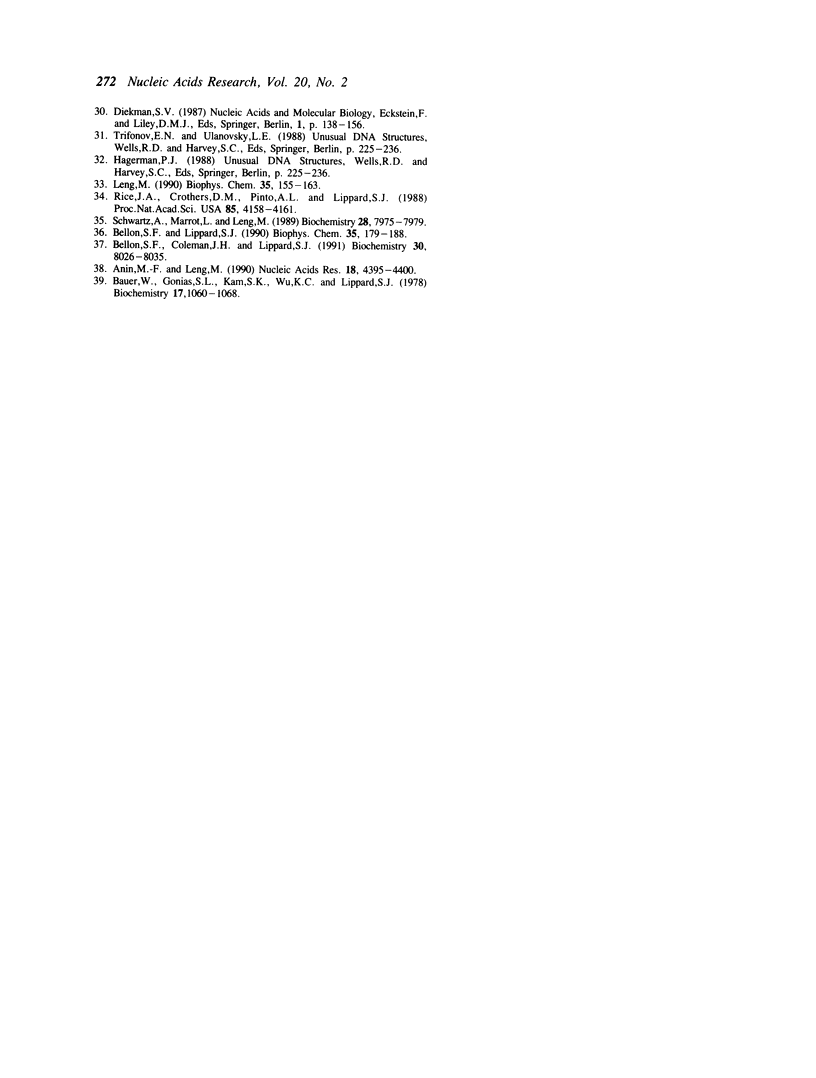
Images in this article
Selected References
These references are in PubMed. This may not be the complete list of references from this article.
- Anin M. F., Leng M. Distortions induced in double-stranded oligonucleotides by the binding of cis- or trans-diammine-dichloroplatinum(II) to the d(GTG) sequence. Nucleic Acids Res. 1990 Aug 11;18(15):4395–4400. doi: 10.1093/nar/18.15.4395. [DOI] [PMC free article] [PubMed] [Google Scholar]
- Bauer W., Gonias S. L., Kam S. K., Wu K. C., Lippard S. J. Binding of the antitumor drug platinum uracil blue to closed and nicked circular duplex DNAs. Biochemistry. 1978 Mar 21;17(6):1060–1068. doi: 10.1021/bi00599a019. [DOI] [PubMed] [Google Scholar]
- Bellon S. F., Coleman J. H., Lippard S. J. DNA unwinding produced by site-specific intrastrand cross-links of the antitumor drug cis-diamminedichloroplatinum(II). Biochemistry. 1991 Aug 13;30(32):8026–8035. doi: 10.1021/bi00246a021. [DOI] [PubMed] [Google Scholar]
- Bellon S. F., Lippard S. J. Bending studies of DNA site-specifically modified by cisplatin, trans-diamminedichloroplatinum(II) and cis-[Pt(NH3)2(N3-cytosine)Cl]+. Biophys Chem. 1990 Apr;35(2-3):179–188. doi: 10.1016/0301-4622(90)80007-t. [DOI] [PubMed] [Google Scholar]
- Brabec V., Palecek E. Interaction of nucleic acids with electrically charged surfaces. II. Conformational changes in double-helical polynucleotides. Biophys Chem. 1976 Jan;4(1):79–92. doi: 10.1016/0301-4622(76)80009-9. [DOI] [PubMed] [Google Scholar]
- Brabec V., Palecek E. The influence of salts and pH on polarographic currents produced by denatured DNA. Biophysik. 1970;6(4):290–300. doi: 10.1007/BF01575324. [DOI] [PubMed] [Google Scholar]
- Burchenal J. H., Kalaher K., O'Toole T., Chisholm J. Lack of cross-resistance between certain platinum coordination compounds in mouse leukemia. Cancer Res. 1977 Sep;37(9):3455–3457. [PubMed] [Google Scholar]
- Eastman A. Reevaluation of interaction of cis-dichloro(ethylenediamine)platinum(II) with DNA. Biochemistry. 1986 Jul 1;25(13):3912–3915. doi: 10.1021/bi00361a026. [DOI] [PubMed] [Google Scholar]
- Eastman A. The formation, isolation and characterization of DNA adducts produced by anticancer platinum complexes. Pharmacol Ther. 1987;34(2):155–166. doi: 10.1016/0163-7258(87)90009-x. [DOI] [PubMed] [Google Scholar]
- Herr W. Diethyl pyrocarbonate: a chemical probe for secondary structure in negatively supercoiled DNA. Proc Natl Acad Sci U S A. 1985 Dec;82(23):8009–8013. doi: 10.1073/pnas.82.23.8009. [DOI] [PMC free article] [PubMed] [Google Scholar]
- Jennerwein M. M., Eastman A., Khokhar A. Characterization of adducts produced in DNA by isomeric 1,2-diaminocyclohexaneplatinum(II) complexes. Chem Biol Interact. 1989;70(1-2):39–49. doi: 10.1016/0009-2797(89)90061-6. [DOI] [PubMed] [Google Scholar]
- Kidani Y., Inagaki K., Iigo M., Hoshi A., Kuretani K. Antitumor activity of 1,2-diaminocyclohexane--platinum complexes against sarcoma-180 ascites form. J Med Chem. 1978 Dec;21(12):1315–1318. doi: 10.1021/jm00210a029. [DOI] [PubMed] [Google Scholar]
- Koo H. S., Wu H. M., Crothers D. M. DNA bending at adenine . thymine tracts. Nature. 1986 Apr 10;320(6062):501–506. doi: 10.1038/320501a0. [DOI] [PubMed] [Google Scholar]
- Leng M. DNA bending induced by covalently bound drugs. Gel electrophoresis and chemical probe studies. Biophys Chem. 1990 Apr;35(2-3):155–163. doi: 10.1016/0301-4622(90)80005-r. [DOI] [PubMed] [Google Scholar]
- Marrot L., Leng M. Chemical probes of the conformation of DNA modified by cis-diamminedichloroplatinum(II). Biochemistry. 1989 Feb 21;28(4):1454–1461. doi: 10.1021/bi00430a005. [DOI] [PubMed] [Google Scholar]
- Maxam A. M., Gilbert W. Sequencing end-labeled DNA with base-specific chemical cleavages. Methods Enzymol. 1980;65(1):499–560. doi: 10.1016/s0076-6879(80)65059-9. [DOI] [PubMed] [Google Scholar]
- Nejedlý K., Kwinkowski M., Gałazka G., Kłysik J., Palecek E. Recognition of the structural distortions at the junctions between B and Z segments in negatively supercoiled DNA by osmium tetroxide. J Biomol Struct Dyn. 1985 Dec;3(3):467–478. doi: 10.1080/07391102.1985.10508435. [DOI] [PubMed] [Google Scholar]
- Noji M., Okamoto K., Kidani Y., Tashiro T. Relation of conformation to antitumor activity of platinum(II) complexes of 1,2-cyclohexanediamine and 2-(aminomethyl)cyclohexylamine isomers against leukemia P388. J Med Chem. 1981 May;24(5):508–515. doi: 10.1021/jm00137a007. [DOI] [PubMed] [Google Scholar]
- Page J. D., Husain I., Sancar A., Chaney S. G. Effect of the diaminocyclohexane carrier ligand on platinum adduct formation, repair, and lethality. Biochemistry. 1990 Jan 30;29(4):1016–1024. doi: 10.1021/bi00456a026. [DOI] [PubMed] [Google Scholar]
- Pendyala L., Arakali A. V., Sansone P., Cowens J. W., Creaven P. J. DNA binding of iproplatin and its divalent metabolite cis-dichloro-bis-isopropylamine platinum (II). Cancer Chemother Pharmacol. 1990;27(3):248–250. doi: 10.1007/BF00685722. [DOI] [PubMed] [Google Scholar]
- Rice J. A., Crothers D. M., Pinto A. L., Lippard S. J. The major adduct of the antitumor drug cis-diamminedichloroplatinum(II) with DNA bends the duplex by approximately equal to 40 degrees toward the major groove. Proc Natl Acad Sci U S A. 1988 Jun;85(12):4158–4161. doi: 10.1073/pnas.85.12.4158. [DOI] [PMC free article] [PubMed] [Google Scholar]
- Schwartz A., Marrot L., Leng M. Conformation of DNA modified at a d(GG) or a d(AG) site by the antitumor drug cis-diamminedichloroplatinum(II). Biochemistry. 1989 Oct 3;28(20):7975–7979. doi: 10.1021/bi00446a001. [DOI] [PubMed] [Google Scholar]
- Vollano J. F., Al-Baker S., Dabrowiak J. C., Schurig J. E. Comparative antitumor studies on platinum(II) and platinum(IV) complexes containing 1,2-diaminocyclohexane. J Med Chem. 1987 Apr;30(4):716–719. doi: 10.1021/jm00387a023. [DOI] [PubMed] [Google Scholar]
- Vrána O., Brabec V., Kleinwächter V. Polarographic studies on the conformation of some platinum complexes: relations to anti-tumour activity. Anticancer Drug Des. 1986 Apr;1(2):95–109. [PubMed] [Google Scholar]



